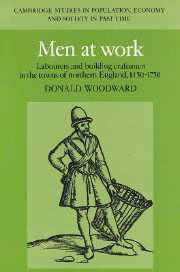Book contents
- Frontmatter
- Contents
- List of tables
- List of appendices
- Preface
- List of abbreviation
- 1 Introduction
- 2 Building craftsmen at work
- 3 The life-cycle of building craftsmen
- 4 Labourers
- 5 Conditions of work for labourers and building craftsmen
- 6 Wage rates in the northern towns
- 7 Towards an understanding of living standards
- Appendices
- Bibliography
- Index
- Cambridge Studies in Population, Economy and Society in Past Time
7 - Towards an understanding of living standards
Published online by Cambridge University Press: 15 October 2009
- Frontmatter
- Contents
- List of tables
- List of appendices
- Preface
- List of abbreviation
- 1 Introduction
- 2 Building craftsmen at work
- 3 The life-cycle of building craftsmen
- 4 Labourers
- 5 Conditions of work for labourers and building craftsmen
- 6 Wage rates in the northern towns
- 7 Towards an understanding of living standards
- Appendices
- Bibliography
- Index
- Cambridge Studies in Population, Economy and Society in Past Time
Summary
If we want to discover not the nominal wage, i.e. the money paid for a certain time or for a certain piece of work, but the actual wage, together with its purchasing power, we are tackling a difficult and complicated problem the solution of which can only be obtained by comparing a number of different data. We ought first to know a man's total wage for a month, a season or a year, and how far it was reduced by either voluntary or compulsory unemployment. For a man may be well paid and yet earn very little, if he does not work every day. Then we should know whether he had any other source of income, as was the case with village workers, who when comparatively well off cultivated their plots of land or grazed their cows on the common, and who when very poor received help from the parish. We should also want to know what each member of the family contributed to the annual family budget. Then, even assuming that we have been able to solve that part of the problem, a no less difficult problem remains to be solved, for we should want to find out how this income was actually spent. And it would not be enough to know what were the price of foodstuffs and the rents.
- Type
- Chapter
- Information
- Men at WorkLabourers and Building Craftsmen in the Towns of Northern England, 1450–1750, pp. 209 - 249Publisher: Cambridge University PressPrint publication year: 1995

